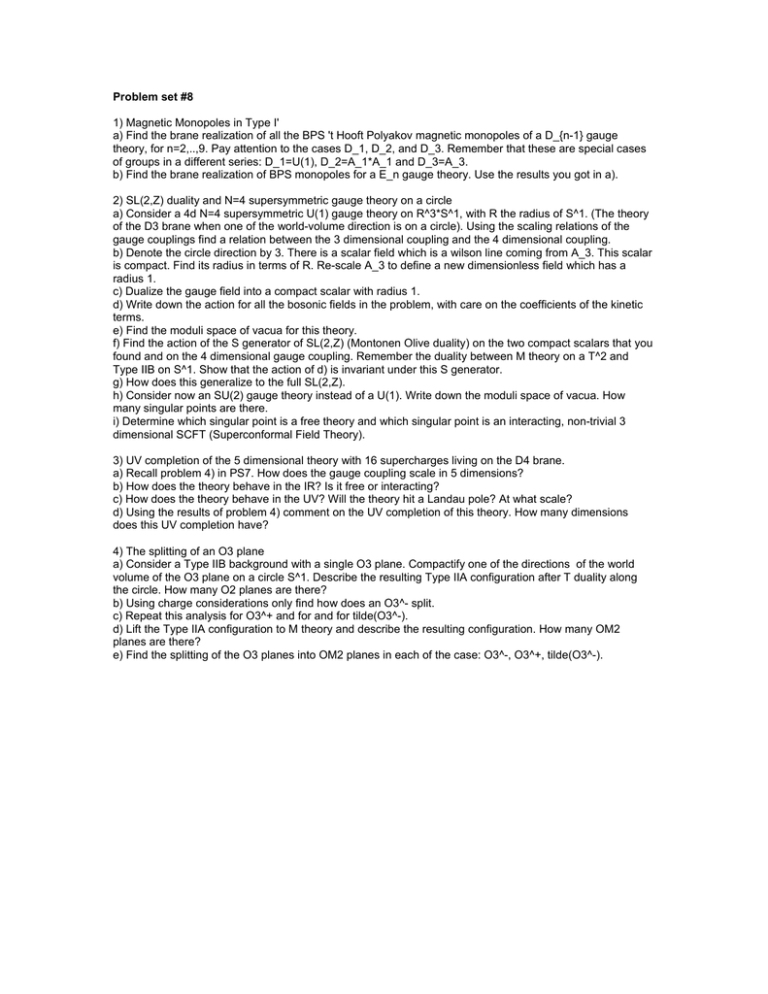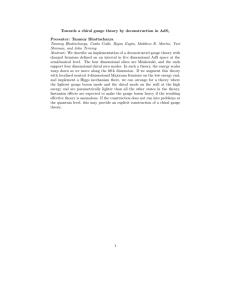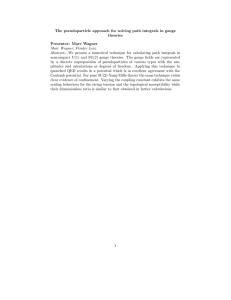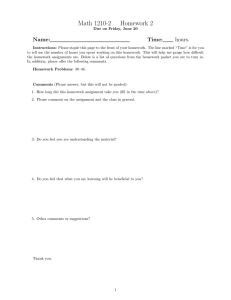Document 13646687
advertisement

Problem set #8
1) Magnetic Monopoles in Type I'
a) Find the brane realization of all the BPS 't Hooft Polyakov magnetic monopoles of a D_{n-1} gauge theory, for n=2,..,9. Pay attention to the cases D_1, D_2, and D_3. Remember that these are special cases of groups in a different series: D_1=U(1), D_2=A_1*A_1 and D_3=A_3. b) Find the brane realization of BPS monopoles for a E_n gauge theory. Use the results you got in a). 2) SL(2,Z) duality and N=4 supersymmetric gauge theory on a circle a) Consider a 4d N=4 supersymmetric U(1) gauge theory on R^3*S^1, with R the radius of S^1. (The theory
of the D3 brane when one of the world-volume direction is on a circle). Using the scaling relations of the
gauge couplings find a relation between the 3 dimensional coupling and the 4 dimensional coupling. b) Denote the circle direction by 3. There is a scalar field which is a wilson line coming from A_3. This scalar is compact. Find its radius in terms of R. Re-scale A_3 to define a new dimensionless field which has a radius 1. c) Dualize the gauge field into a compact scalar with radius 1. d) Write down the action for all the bosonic fields in the problem, with care on the coefficients of the kinetic terms. e) Find the moduli space of vacua for this theory.
f) Find the action of the S generator of SL(2,Z) (Montonen Olive duality) on the two compact scalars that you found and on the 4 dimensional gauge coupling. Remember the duality between M theory on a T^2 and Type IIB on S^1. Show that the action of d) is invariant under this S generator. g) How does this generalize to the full SL(2,Z). h) Consider now an SU(2) gauge theory instead of a U(1). Write down the moduli space of vacua. How
many singular points are there. i) Determine which singular point is a free theory and which singular point is an interacting, non-trivial 3 dimensional SCFT (Superconformal Field Theory). 3) UV completion of the 5 dimensional theory with 16 supercharges living on the D4 brane.
a) Recall problem 4) in PS7. How does the gauge coupling scale in 5 dimensions? b) How does the theory behave in the IR? Is it free or interacting? c) How does the theory behave in the UV? Will the theory hit a Landau pole? At what scale? d) Using the results of problem 4) comment on the UV completion of this theory. How many dimensions does this UV completion have? 4) The splitting of an O3 plane a) Consider a Type IIB background with a single O3 plane. Compactify one of the directions of the world volume of the O3 plane on a circle S^1. Describe the resulting Type IIA configuration after T duality along
the circle. How many O2 planes are there?
b) Using charge considerations only find how does an O3^- split. c) Repeat this analysis for O3^+ and for and for tilde(O3^-). d) Lift the Type IIA configuration to M theory and describe the resulting configuration. How many OM2 planes are there? e) Find the splitting of the O3 planes into OM2 planes in each of the case: O3^-, O3^+, tilde(O3^-).







